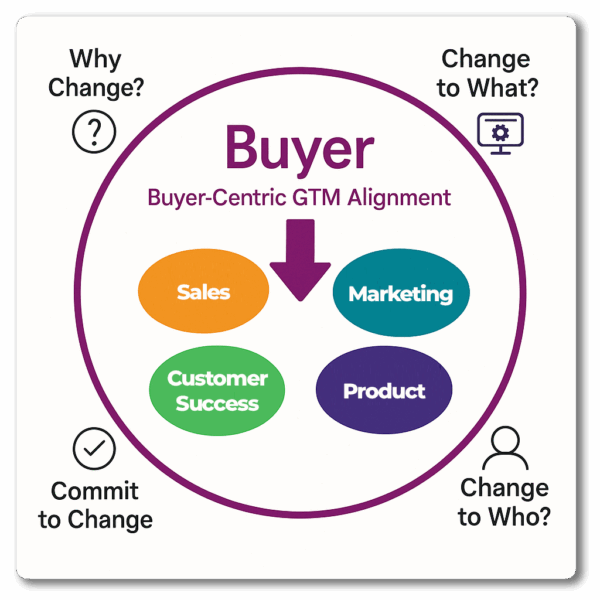
For years, we’ve fixated on sales and marketing alignment. I’ve long advocated for collaboration over alignment — believing it mattered more for teams to work together than to share KPIs. But times have changed and so has my perspective.
It’s no longer just about internal structures. It’s about the buyer and the shifting external environment. Think back: When money was cheap and markets were stable, vendor-buyer dynamics were simpler. Decisions carried less risk and scrutiny was lighter.
Fast-forward to today: chaotic government decision-making, economic pressure, remote workforces and AI have reshaped everything. If a target account is big enough to track and a deal big enough to matter, these factors are now the game-changers.
The real shift? Aligning with the customer — the buyer. Whether we call it alignment or collaboration, we’ve been missing the point: What matters most is connecting meaningfully with those we aim to serve. Obvious in hindsight, isn’t it?
Transition to buyer alignment in a changing environment
We need to reframe our approach. In the past, we focused on improving internal processes, streamlining GTM functions and driving efficiencies. That inward focus sidelined what matters most: the buyer.
These shifts demand greater emotional intelligence from all of us. Buyers are navigating similar pressures to your organization:
- Tighter budgets.
- Heightened risk aversion.
- Greater scrutiny on every investment.
As a result, they require more trust, deeper knowledge and broader internal validation than ever before. In this new reality, aligning sales with marketing is no longer enough. They both have to align with the customer.
Why the old playbook no longer works
Product “pitch-slaps” are doing more damage than good. Too often, sales and marketing rely on rigid playbooks or motions completely misaligned with buyer needs. The collective approach to content — whether long-form documents, videos or sales decks — has consistently missed the mark.
- 65% of business and tech professionals say buyer-facing content goes unused due to poor findability, relevance or quality (Forrester).
- 71% of B2B decision-makers are often disappointed by gated content — even from trusted vendors (CMI).
- Nearly 90% of buyers expect relevant content at every stage of their journey (Forrester).
Shortcuts won’t work
The key reason for failure is cognitive load. It’s simply too hard to memorize all the elements and how they interact.
Consider the complexity: across GTM strategy, you might be navigating over 67,000 permutations — spanning five industries, three company sizes, three journey stages, five buyer personas, five core challenges, four products and 15 capabilities.
The solution doesn’t get easier. These dimensions don’t operate independently; they intertwine to impact messaging, account strategy, tone, proof points and call-to-action structures. The result is not just a multilayered strategy but requires the orchestration of these factors for each large deal cycle.
The answer isn’t memorization or endless training. The answer is a fundamentally new approach.
Dig deeper: It’s time for B2B marketing to understand its GTM role
Develop a buyer-centric strategy
A buyer-centric strategy directs the sales approach and marketing content needs. Buyer needs are not funnel stages — those are inward dimensions. A buyer-centric strategy refocuses sales and marketing efforts to better suit a risk-averse buyer by viewing the engagement through their eyes.

Why change?
When approaching a large target or conceiving a segment-based campaign, identify and articulate why buyers would consider changing from their current state. What are the pain points and challenges that necessitate change?
Change to what?
Rather than jumping to product features, work with the buyer to explore potential solutions that could meet the buyer’s newly recognized needs, shaping their evaluation criteria. If you shape the requirements, you narrow the solution options.
Change to who?
Here, buyers assess and select the vendor or partner that best fits their solution requirements, comparing alternatives to identify the optimal choice.
Commit to change
In the final stage, buyers decide to proceed with their selected solution, solidifying partnerships and planning implementation strategies to effectively enact change.
The goal? Through each stage, Sales and Marketing teams must have their messaging, content and engagement strategies tuned to support and guide buyers towards an informed, confident decision.
Key components of buyer-centric engagement
These elements represent a fundamental shift in how businesses engage with and consider their prospects and customers.
Data-driven insights and customized solutions
Data insights are essential to understanding the buyer’s needs and their journey. These insights can tailor engagement strategies, ensuring relevant solutions align with specific buyer-defined criteria.
Every interaction should be an opportunity to learn more, add value and use this to move past generalized options. While our trade tends to talk a lot about personalization, it’s fundamentally impossible to personalize without the insights generated by this process.
Trust and partnership
The antidote to risk aversion is trust. Prioritize transparency and reliability in every aspect of interaction. You must consistently deliver on promises and honestly communicate about what you can do.
In this, establish a partnership rather than a transactional relationship. Doing so, sellers learn more, engage with buyers more deeply, addressing shared challenges and demonstrating long-term commitment to mutual success.
Dig deeper: 7 steps to creating an audience-based B2B marketing plan
Proactive role as trusted advisors
Sellers and marketers must become trusted advisors, offering expertise and guidance beyond the immediate sale. That requires providing strategic insights that help buyers navigate their complexities and make informed decisions.
Accomplishing this requires providing buyers with relevant content and perspectives, demonstrating an understanding of broader industry trends and challenges.
Using technology and innovation
AI, especially when custom-trained to understand the enormity of the vendor and buyer connective topics — personas, firm types, capabilities and functionalities, marketing messages and market positioning — can be an “easy button” to diagnose buyer needs precisely.
First-party intent and data management tools also enable better understanding buyer needs. They aggregate and assemble data insights in an account-structured and time-sequenced manner.
Advanced analytics, like causal AI, help GTM teams understand time-lagged stimulus and response interactions and make better decisions with higher performance.
Dig deeper: Could AI be what finally aligns marketing and sales teams?
Final thoughts
Is my advice easy? No. But the option is to continue drifting away from your target audiences. The drift is already happening. What will you do about it? Doing more of the same, more efficiently, isn’t helpful. Finding a new “playbook” or defining a new “motion” misses the point.
If there’s one area that enables this shift, it’s customer research. Mature product marketing should make you more knowledgeable about your audience than any competitor — more informed about buyer options, and as deeply aware of your competitors as they are of themselves. Most importantly, treat that knowledge as a strategic asset — and invest in building and using it.
The post Your GTM strategy needs a buyer-centric redesign appeared first on MarTech.
